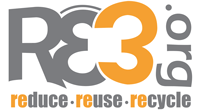
Guest Blogger - Michigan Mary with help from Envision Plastics
Knowing what to recycle can be downright confusing at times. Most of us have the basics down - soda cans, milk jugs, newspaper. What about those in between items that just don’t fit into any of the prescribed categories?
Recently we heard an analogy here at RE3.org that helped clear things up for us and thought you might appreciate it as well. We have always been curious as to why some types of plastic are not able to be recycled. If we can recycle water bottles why not plastic cups? Why can’t all #2’s be recycled?
Just think about a pancake and a biscuit - although they are made of the same ingredients, (water, eggs, flour and milk) there are different quantities of these ingredients within each item. Pancake batter is runnier than biscuit batter making it easier to pour whereas biscuit batter is more easily molded. Also, once you make the batter for each item, you cook them at similar temperatures but for different lengths of time.
Pancakes cook relatively quickly at a high direct heat, while biscuits have to be put in an oven and given time to bake. Plastics are the same way. They all have the same initial components which constitute being plastic and relate to the number they are given (i.e., 1-7), however, the individual makeup within each product dictates our ability to recycle it. Injection grade plastics like a water bottle are similar to pancakes and mold grade plastics such as a fast food container is similar to biscuits. So even though a plastic item may have #2 on the bottom of it, not all #2’s are the same.
We know it is hard to throw away all those plastics that you wish you could add to your recycling stash but it’s actually better for the recycling facilities when the products obtained are ones that can actually be reused.

5 comments:
I like the pancake vs. biscuit analogy, and not just because I love both those foods. BTW, that's an interesting photo. I don't believe you'll find that butter in the dairy department.
What I wonder is why there aren't more numbers assigned on containers so that consumers don't really need to fool with the guess work?
Dodge This - Good catch regarding the photo. It has been switched out. I hope you got a good laugh out of that. I did once you pointed it out.
Teg - I'm not sure we need more numbers since technically both a bottle and a tub have the same components but an easy way to distinguish the two items and their recyclability for the general public would be useful.
I thought water bottles were mostly #1 and never #2. Rule of thumb is that if is clear it could be #1 but not #2. If it is milky it could be #2 or #1 but most likely #2.
Anonymous - You are correct. I think all water bottles and drink bottles in general are a number 1 plastic. Number 2 plastic bottles are usually laundry detergent jugs, shampoo bottles and milk jugs.
However, you can find other plastic items that are #1 and #2 that are not bottle shaped. Like a bucket or drainage pipes.
Post a Comment